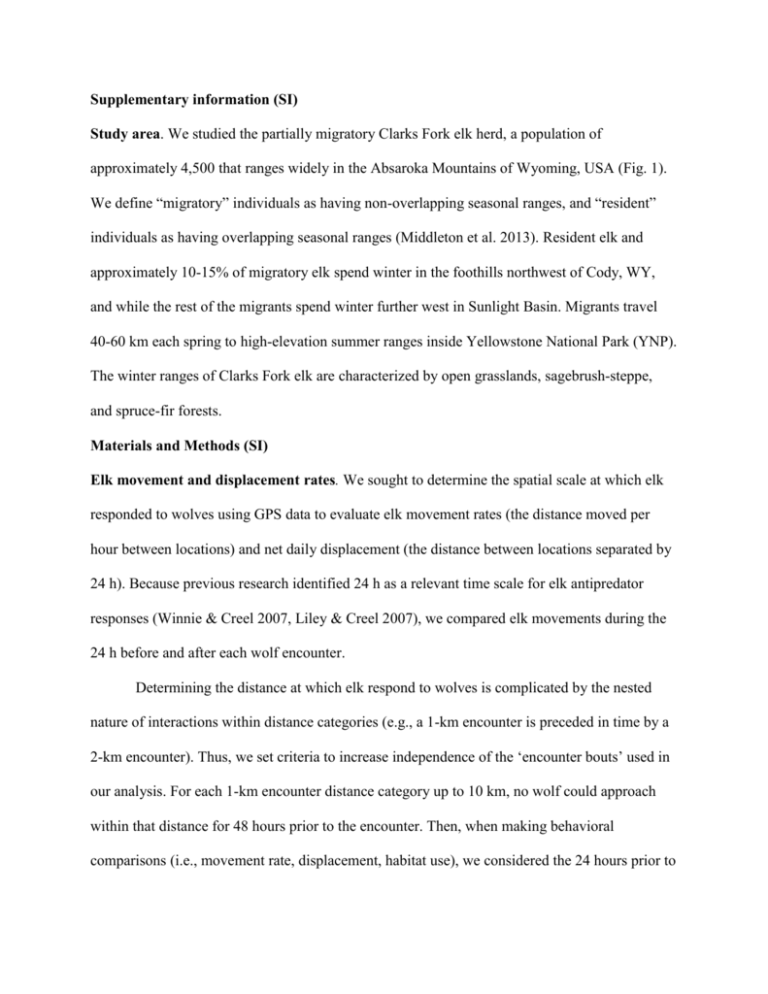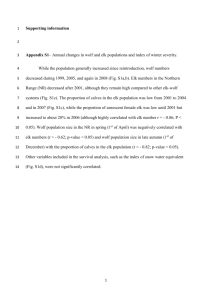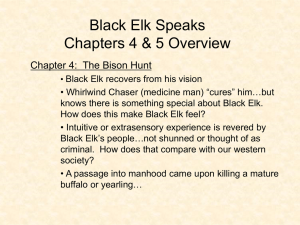ele12133-sup-0001-SupportingInformation
advertisement

Supplementary information (SI) Study area. We studied the partially migratory Clarks Fork elk herd, a population of approximately 4,500 that ranges widely in the Absaroka Mountains of Wyoming, USA (Fig. 1). We define “migratory” individuals as having non-overlapping seasonal ranges, and “resident” individuals as having overlapping seasonal ranges (Middleton et al. 2013). Resident elk and approximately 10-15% of migratory elk spend winter in the foothills northwest of Cody, WY, and while the rest of the migrants spend winter further west in Sunlight Basin. Migrants travel 40-60 km each spring to high-elevation summer ranges inside Yellowstone National Park (YNP). The winter ranges of Clarks Fork elk are characterized by open grasslands, sagebrush-steppe, and spruce-fir forests. Materials and Methods (SI) Elk movement and displacement rates. We sought to determine the spatial scale at which elk responded to wolves using GPS data to evaluate elk movement rates (the distance moved per hour between locations) and net daily displacement (the distance between locations separated by 24 h). Because previous research identified 24 h as a relevant time scale for elk antipredator responses (Winnie & Creel 2007, Liley & Creel 2007), we compared elk movements during the 24 h before and after each wolf encounter. Determining the distance at which elk respond to wolves is complicated by the nested nature of interactions within distance categories (e.g., a 1-km encounter is preceded in time by a 2-km encounter). Thus, we set criteria to increase independence of the ‘encounter bouts’ used in our analysis. For each 1-km encounter distance category up to 10 km, no wolf could approach within that distance for 48 hours prior to the encounter. Then, when making behavioral comparisons (i.e., movement rate, displacement, habitat use), we considered the 24 hours prior to the encounter “undisturbed” at its respective distance threshold. At distance categories greater than 1 km, we excluded encounters where wolves approached within the next closest distance threshold (i.e., for a 2-km encounter, a wolf could not come closer than 1 km). This approach yielded on average 207 encounter bouts per distance category (range 100-298). We provide a visual example of this approach in Fig. S1. We explored whether a 24-h time scale was appropriate by examining movement rates before and after 1-km encounter bouts. Because elk movements are entrained to time of day, we standardized movement data by subtracting each individual’s baseline movement rate at each time of day from the observed rate at that time during the encounter bout. We estimated baseline movement rates for each 3-hr time period using locations when wolves were beyond 1 km for more than 48 h. Elk foraging behavior and habitat use. We generally obtained one 15-30 minute focal observation of each individual at least once every two weeks. We conservatively defined vigilance as occurring when an animal lifts it head, breaks into a gaze with its ears cocked forward, and stops chewing, while either standing or bedded (Winnie & Creel 2007, Liley & Creel 2007). To evaluate the influence of wolves, we calculated the nearest distance of a GPScollared wolf to the observation site during the preceding 24 hours. We obtained on average 38 observations per distance category (range 12-78). We discarded any observations where we saw evidence that elk were responding to the presence of observers. In our analysis of habitat use, distance-to-timber was expressed as a continuous raster, with negative values inside forest edges, whereas openness was the count of open (non-forested) 10-m pixels within a 250 m moving window around the elk location; both were based on the National Land Cover Data for 2006. Individual variation in wolf encounter frequency. We considered the possibility that our collaring of 1-3 wolves per pack led us to underestimate the frequency of elk-wolf encounters. However, when two or more wolves were collared in a pack (n = 3 packs, n = 8 wolf-pairs), 75% of paired locations were within 0.26 km (Sunlight pack), 0.47 km (Absaroka pack), and 0.89 km (Hoodoo pack), suggesting a relatively high degree of pack cohesion in winter (similar to studies of wolf social behavior; e.g., Peterson et al. 1984). Thus, most 1-km encounters were likely detected. Elk body fat and pregnancy. During the elk recaptures, elk were immobilized with a dart (Pneu-dart, Williamsport, PA, USA) containing either a carfentanil-xylazine mixture or BAM™ (ZooPharm, Fort Collins, CO, USA). While elk were immobilized, we collected a rump bodycondition score, measured rump-fat thickness using ultrasonography, and measured chest girth circumference (Cook et al. 2010). Non-pregnant body mass was calculated from chest-girth measurements using equations for immobilized, sternally-recumbent female elk (Cook et al. 2004). Ingesta-free body fat (hereafter “body fat”) was estimated using a previously validated (Cook et al. 2004, Cook et al. 2010, Cook 2011) arithmetic combination of rump body-condition score and rump-fat thickness allometrically scaled using non-pregnant body mass. These predictive equations were originally developed from studies of captive elk and subsequently refined in field studies of more than 20 free-ranging elk populations in the western United States. During the initial captures, we determined pregnancy using pregnancy-specific protein B (PSPB) analysis of blood serum (BioTracking, Moscow, ID, USA). During later recaptures, pregnancy was determined with ultrasound via rectal entry. Non-pregnancies were independently verified using PSPB (n = 14). All animal captures were conducted under approved University of Wyoming Institutional Animal Care and Use Committee protocols. References (SI) 1. Cook, J.G., Johnson, B.K., Cook, R.C., Riggs, R.A., Delcurto, D., Bryant, L.D., et al. (2004). Effects of summer-autumn nutrition and parturition date on reproduction and survival of elk. Wildlife Monogr., 155, 1-61. 2. Cook, R.C. (2011). A multi-regional evaluation of nutritional condition and reproduction in elk. Ph.D. dissertation, Washington State University. 3. Cook, R.C., Cook, J.G., Stephenson, T.R., Myers, W.L., McCorquodale, S.M., Vales, D.J., et al. (2010). Revisions of rump fat and body scoring nutritional condition indices for deer, elk, and moose. J. Wildlife Manage., 74, 880-896. 4. Liley, S. & Creel, S. (2007). What best explains vigilance in elk: characteristics of the prey, predators, or the environment? Behav. Ecol., 19, 245-254. 5. Middleton, A.D., Kauffman, M.J., McWhirter, D.E., Cook, J.G., Cook, R.C., Nelson, A.A., et al. (2013). Animal migration amid shifting patterns of phenology and predation: Lessons from a Yellowstone elk herd. Ecology, in press. 6. Peterson R.O., Woolington, J.D., & Bailey, T.N. (1984). Wolves of the Kenai Peninsula. Wildlife Monogr., 88, 3-52. 7. Winnie, J. & Creel, S. (2007). Sex-specific behavioral responses of elk to spatial and temporal variation in the threat of wolf predation. Anim. Behav., 73, 215-225. Figure legends (SI) Figure S1. For each elk location within the 95% MCP of a collared wolf pack, we calculated the distance to the nearest wolf. We used two rules to assign “encounter bouts” to distance categories, as illustrated by this diagram of a hypothetical 2-km encounter. (1) For the 48 hours prior to the encounter, we required that the wolf was beyond 2 km from the individual elk. After coming within 2 km (i.e., the event which defined the encounter), we required that the wolf come no closer than the next nearest distance category (in this case, 1 km). Figure S1






